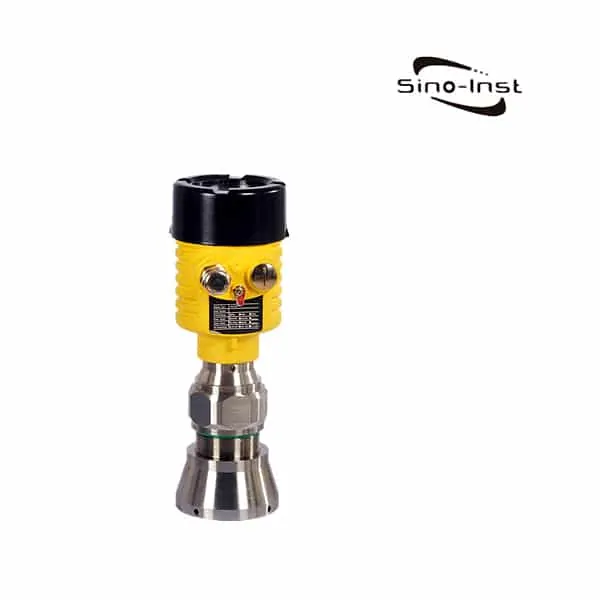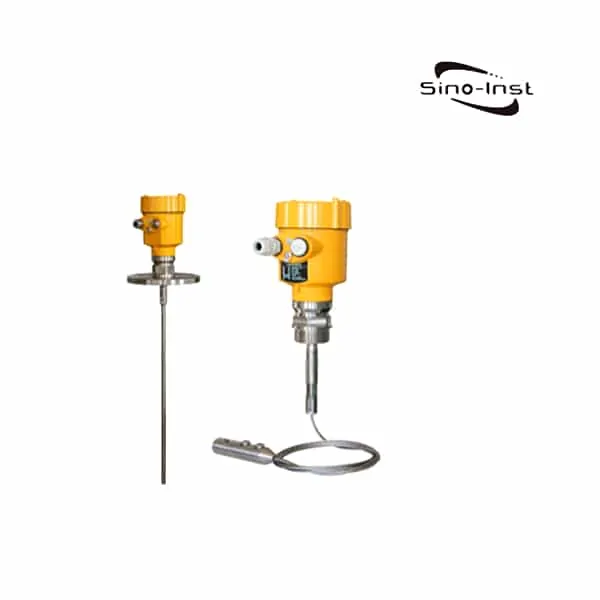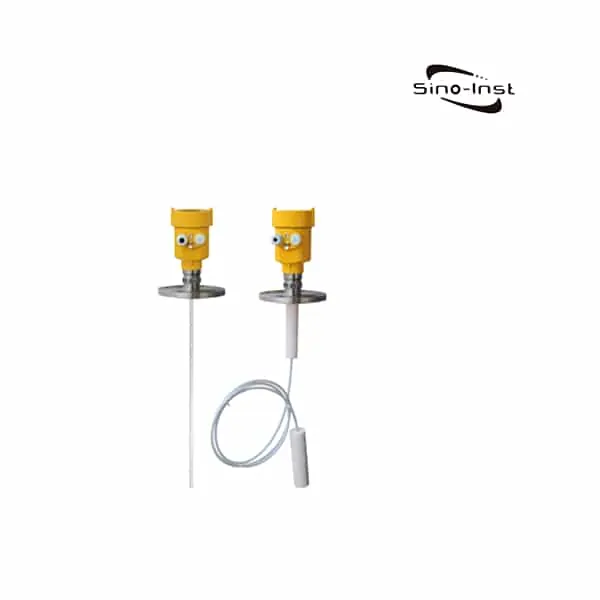Frequency modulated continuous wave radar also known as FMCW radar. Frequency modulated continuous wave radar level sensors antenna has been further optimized. The new and fast microprocessor can perform higher rate signal processing.

Frequency modulated continuous wave radar refers to continuous wave radar whose transmitting frequency is modulated by a specific signal. Radar is divided into two categories: pulse radar and continuous wave radar according to the type of transmitted signal. The signal emitted by Frequency Modulated Continuous Wave Radar can be single-frequency continuous wave (CW) or frequency-modulated continuous wave (FMCW). FMCW radar can be used for both range measurement and Speed measurement, and the advantages in short-distance measurement are increasingly obvious.
Sino-Inst offers a variety of Frequency modulated continuous wave radar for industrial level measurement. If you have any questions, please contact our sales engineers.
Features of FMCW Radar Level Sensor
- 120GHz-130GHz FM wave radar. Terahertz radar used in industrial measurement field
- 10GHz ultra-large FM scanning frequency width. Wide application range
- 320*240dot TFT color LCD display. Easy to operate and friendly interface
- Support standard HART, MODBUS, PROFIBUS bus protocol
- Support multiple operation and configuration methods such as PC setting software, mobile phone APP, LCD keyboard module, tank side meter, etc.
- 24VDC, 220VAC two power supply models
- Simple installation structure. Adapt to various installation forms on site
Specifications of SI-FMF12 FMCW Radar Level Sensor
| Measuring medium: | Liquid |
| Measuring range: | 0.05m~35m |
| Process connection: | G2A thread/flange≥DN65 |
| Process temperature: | -40~110℃ |
| Process pressure: | -0.1~1.6 MPa |
| Accuracy: | ±2mm |
| Protection level: | IP67 |
| Frequency Range: | IP67 |
| power supply: | Two-wire system (DC24V)/four-wire system (DC12V~24V)/four-wire system (AC220V) |
| Explosion-proof grade: | Exia ⅡC T6 Ga / Exd IIC T6 Gb |
| Housing: | Aluminum/plastic/stainless steel |
| Signal output: | Two-wire system 4…20mA/HART protocol Four-wire system 4…20mA/RS485 Mod bus |
Extended Reading: Influence of Dielectric Constant on Liquid Level Measurement | Radar-Guided Wave Radar Level Meter
Frequency modulated continuous wave radar pros
120GHz-130GHz FM wave FMCW radar product (also called THz terahertz radar).
It uses a higher frequency THz band than Ku-band radar.
It has important applications in remote target detection, strong smoke and dust environment, long-distance imaging, multi-spectral imaging, etc. And can detect smaller targets than microwave radar and achieve more precise positioning. With higher resolution and stronger confidentiality.
What are terahertz (THz) electromagnetic waves?
It refers to electromagnetic waves and electromagnetic radiation with electromagnetic wave frequency between 100GHz ~ 10,000GHz (10THz).
This band is the area that humans have the least understanding and application development so far. Terahertz lies between mid-infrared and microwave on the electromagnetic spectrum, and represents the transition stage from quantum mechanism transmission theoretical physics to classical mechanism transmission theoretical physics.
1THz(=1000GHz) The wavelength of electromagnetic wave is 300um (0.3mm is about the diameter of human hair)
Difference between CW radar and FMCW radar
Radars are divided into pulse radars and continuous wave radars according to the types of transmitted signals. Conventional pulse radar emits periodic high-frequency pulses. Continuous wave radar emits continuous wave signals.
The signal emitted by continuous wave radar can be single frequency continuous wave (CW) or frequency modulated continuous wave (FMCW). There are also many ways of frequency modulation. The common ones are triangle wave, sawtooth wave, code modulation or noise frequency modulation.
Among them, the single-frequency continuous wave radar (CW) can only be used for speed measurement, not distance measurement. The FMCW radar can measure both range and speed, and its advantages in short-range measurement are becoming increasingly obvious.
From Wikipedia, we can learn more about Continuous-wave radar.
Frequency Modulated Continuous Wave Radar Working Principle

FM wave radar level sensor and distance formula:
Among them: C speed of light; fd Doppler frequency shift; fu triangle rising edge difference frequency; f0 FM initial frequency; T signal period; B signal bandwidth
The distance resolution depends on the frequency resolution of the DFT operation (Frequency Resolution). The frequency resolution of the DFT Fres is equal to:

①
T is the corresponding sampling time of the non-zero sampling value used for the DFT operation. If you use FFT + zero padding method to calculate the spectrum. T is the time corresponding to the sampled value of the non-zero-filled point.
The distance corresponding to the frequency resolution Fres is the range resolution Sres of the radar. Then, how to calculate the range resolution of the FMCW radar?
B: Frequency modulation width, unit Hz
T: Actual frequency modulation, in seconds
C: Speed of light, 3*10^8 meters/second
S: the distance between the radar and the object, meters
V: Frequency modulation speed, Hz/sec
t: wave propagation time, sec

V=BW/T ②
t= 2S/C ③

Assume that T is sampling during the entire frequency modulation period. And all sampling points are used for DFT calculation. According to ④ and ①,

which is

This is the calculation formula for the minimum range resolution that FMCW can obtain when the frequency modulation bandwidth is determined.
In actual use, the sampling time will be slightly shorter than the actual frequency modulation T. That is, Fres will be larger in value. So Sres will also become larger in value.
FMCW vs Pulse radar
VEGAPULS has a good explanation video about PULSE and FMCW technology | Radar level measurement. Let’s take a look together.
Video source: https://www.youtube.com/watch?v=eAngy1B1FP
Pulse Radar
Pulse radar is a precision tracking radar. Each time it emits a pulse, the antenna can form several beams at the same time, and compare the amplitude and phase of the echo signal of each beam.
When the target is located on the antenna axis, the amplitude and phase of the echo signal of each beam are equal, and the signal difference is zero.
When the target is not on the antenna axis, the amplitude and phase of the echo signals of each beam are not equal, resulting in signal difference.
Drive the antenna to the target until the antenna axis is aligned with the target, so that the high and low angle and azimuth angle of the target can be measured.
The sum of the signals received by each beam can measure the distance of the target. In order to realize the measurement and tracking of the target.
FMCW
FM continuous wave radar refers to a continuous wave radar whose transmitting frequency is modulated by a specific signal, such as weather radar.
FM continuous wave radar obtains the distance information of the target by comparing the difference between the frequency of the echo signal at any time and the frequency of the transmitted signal at that time.
The distance is proportional to the frequency difference between the two. The radial velocity and distance of the target can be obtained by processing the measured frequency difference between the two.
Compared with other range and speed measurement radars, the structure of FM continuous wave radar is simpler.
FMCW radar has rich technical experience, low transmit power peak required, easy modulation, low cost, and simple signal processing, so it is a commonly used radar system in automotive radars.
LFMCW radar, i.e., the carrier signal frequency changes linearly with time.
FAQ
What is frequency modulated continuous wave?
FM continuous wave radar refers to a continuous wave radar whose transmitting frequency is modulated by a specific signal.
The principle of frequency modulated continuous wave (FMCW) radar is to send a continuous signal with a certain bandwidth and linear change in frequency, and then perform fast Fourier transform on the received continuous signal.
The time difference between the two signals is calculated by the frequency difference between the sending and receiving signals. Finally, like the pulse wave radar level meter, the corresponding distance value is obtained from the time difference.
FMCW radar can obtain very high accuracy, and its accuracy mainly depends on the linearity and temperature drift of the voltage controlled oscillator.
What does continuous wave mean?
A continuous wave or continuous waveform (CW) is an electromagnetic wave of constant amplitude and frequency, typically a sine wave, that for mathematical analysis is considered to be of infinite duration.
What does Fmcw stand for?
FMCW is short for Frequency Modulated Continuous Wave.
Sino-Inst offers over 10 FMCW Radar Level Transmitters for level measurement. About 50% of these are float liquid level meters, 40% is the Solid level sensors.
A wide variety of FMCW Radar Level Transmitters options are available to you, such as free samples, paid samples.
Sino-Inst is a globally recognized supplier and manufacturer of FMCW Radar Level Transmitters instrumentation, located in China.
Request a Quote

Wu Peng, born in 1980, is a highly respected and accomplished male engineer with extensive experience in the field of automation. With over 20 years of industry experience, Wu has made significant contributions to both academia and engineering projects.
Throughout his career, Wu Peng has participated in numerous national and international engineering projects. Some of his most notable projects include the development of an intelligent control system for oil refineries, the design of a cutting-edge distributed control system for petrochemical plants, and the optimization of control algorithms for natural gas pipelines.




